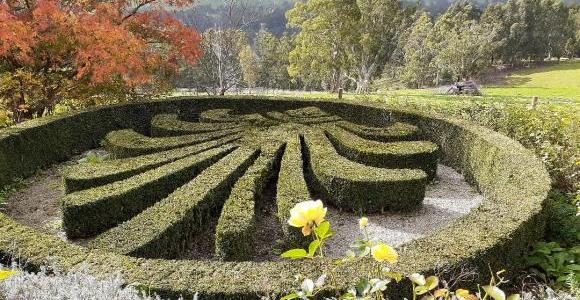
Broughton Hall, Jindivik
You are here

On a cold damp Autumn morning 24 members set out early to go by bus to Jindivick, Gippsland (85km) to visit The Garden at Broughton Hall, the garden and home of David Musker, a former art teacher, landscape designer who runs a rare plants nursery and Philip Hunter, a physiotherapist and gardener.
On arrival David Musker, the creator of the garden, met us for our guided tour of the extensive garden (six acres). It was a little overcast but no rain. We walked through the birch forest and David’s rare plant nursery/shop before entering the large courtyard in front of the house. The terraced garden is behind the house which is north facing.
26 years ago they had a house built on the ridge overlooking the Tarago Reservoir and the great view. Banks, lawns, paths, steps and garden beds were designed and constructed at that time. Steps lead down to each of the five terraces through a central axis and gently sloping gravel paths wind around either end and down through the terraces. At the start 500 birch trees were planted with 30 more each year, creating the birch forest. Cherry trees were planted near the central axis which gives them protection from the strong winds.
The garden sits in the middle of farmland with the Reservoir beyond. The property was selected for its rainfall (1000mm a year), soil type – volcanic, and altitude, all of which give for a faster growing garden with a borrowed landscape. David said the garden needed to be impressive and interesting to keep the visitors’ attention on the garden not the view. Now they comment on the view but rave about the garden.
The hedges are what jump out at you when entering the garden. The tightly clipped hedges define the various garden areas and contrast beautifully with the cascading foliage within. English box are used in the upper garden for their dense green colour (pruned twice a year) and lower down box privet which is hardier, grows quickly, needs no feeding and less water (pruned every six weeks in the growing season). The hedges had just been pruned and the gravel paths raked prior to our visit. Throughout the garden are carefully chosen and placed garden ornaments.
At the foot of the garden before the adjoining pasture there is a rock outcrop with many interesting textured and spiky plants around it and nearby is a gymea lily which has grown very big in the volcanic soil.
David is a plantsman, with an interest in rare plants, so it was a joy to wander around the densely planted trees, shrubs and perennials all with interesting foliage and texture. Some of the plantings included large Cotinus (smoke trees/bushes) with their beautiful autumnal colour, mahonias, phlomis, persecaria, many roses, including climbing (on the colonnades), tall hydrangea paniculata, a 26 year old cotoneaster horizontalis hedge which has red berries in Spring, clipped box balls etc etc. There is a yellow garden to the east with the occasional blue plant and also a pink garden. In the Spring the wonderful bulbs and blossoms explode and then the roses and perennials bloom, etc. Many plants self-seed and are allowed to spread in a controlled way which is beneficial in a large garden. A truely wonderful garden.
After our tour we enjoyed morning tea in the beautiful garden room with its own courtyard. We then spent a little time in the adjoining rare plant nursery. A new silver leaf hellebore was purchased by a number of members. We enjoyed lunch at Costello’s in Pakenham before returning home. It was a very memorable trip. A big thank you to the organisers.








